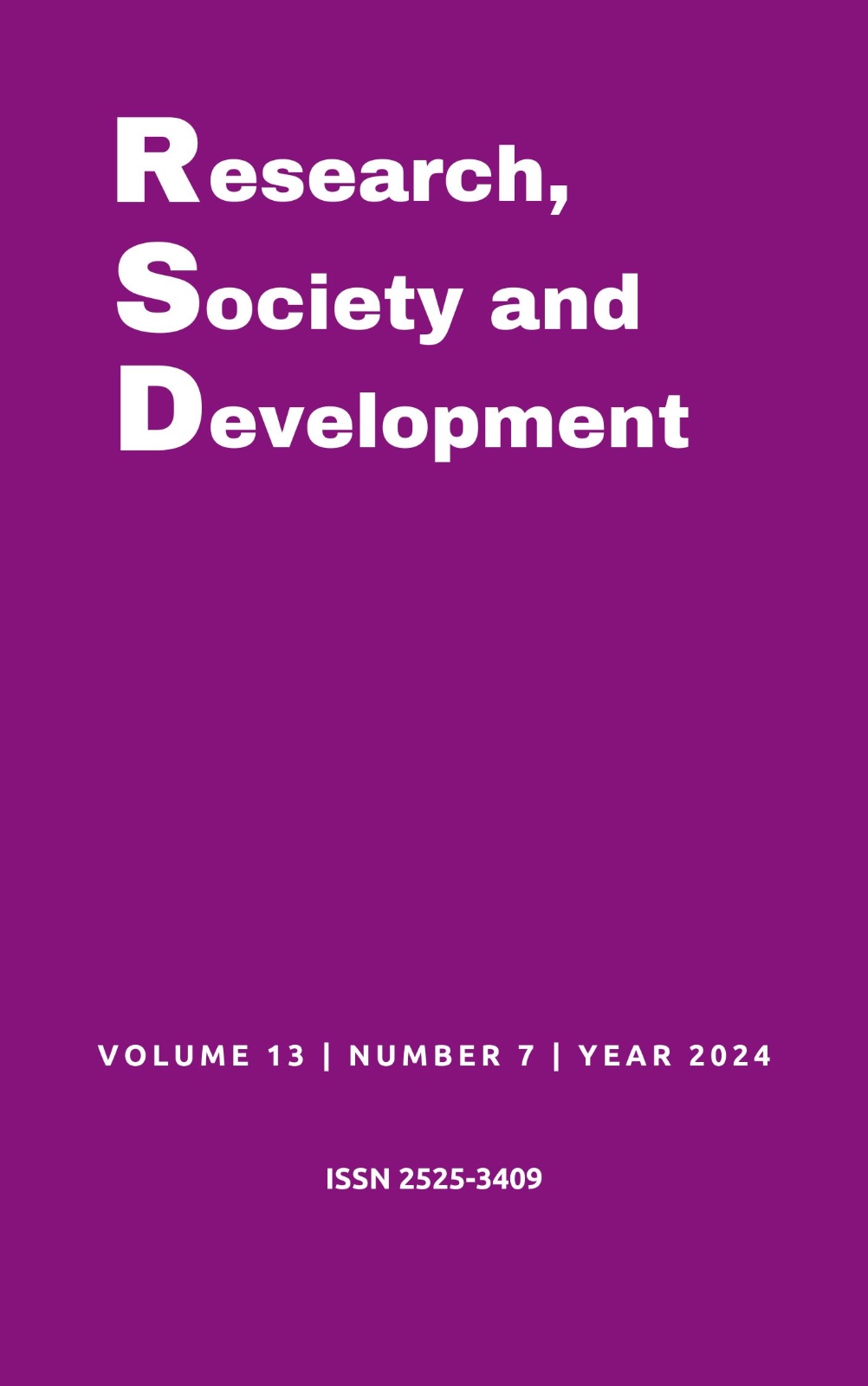Lingual Frenotomy in a 1-month-old baby: Case report
DOI:
https://doi.org/10.33448/rsd-v13i7.46460Keywords:
Lingual frenum, Frenotomy, Child, Surgery, Ankyloglossia.Abstract
The objective of this work was to carry out a case study about the anomalous lingual frenulum in infants, exposing the consequences of such an anomaly, means for diagnosis, most viable treatment and its results. The methodology was developed through a clinical case report associated with research into scientific articles in order to support the study and enrich this present work. This anomaly interferes with tongue movements during lalation, crying and sucking, which can cause discomfort during breastfeeding and affect the child's weight. It is necessary to emphasize that the complete or partial fusion of the tongue on the floor of the mouth is called ankyloglossia, and frenotomy is a procedure considered to be very effective in these cases. Frenotomy is a minimally invasive technique, with the expectation of mild postoperative pain or, in some cases, no pain, and provides immediate results. In the case in question, a one-month-old male baby was evaluated at the Dental Clinic of the Tiradentes University, where after taking an anamnesis, clinical examination and tongue test, he was diagnosed with ankyloglossia and the chosen treatment was frenotomy. Shortly after performing the technique, there were significant improvements in stomatognathic functions, mobility and posture of the tongue. Therefore, it is concluded that an efficient diagnosis and intervention in the first months of life make all the difference in the child's life.
References
Ballard, J. L., Auer, C. E., & Khoury, J. (2002). Ankyloglossia: Assessment, incidence, and effect of frenuloplasty on the breastfeeding dyad. Pediatrics, 110(5), e63.
Barberá-Pérez, P. M., et al. (2021). Prevalence of ankyloglossia in newborns and impact of frenotomy in a Baby-Friendly Hospital. Boletín Médico del Hospital Infantil de México, 78(5), 418-423.
Brasil. (2014). Lei nº 13.002, de 20 de junho de 2014. Obriga a realização do Protocolo de Avaliação do Frênulo da Língua em Bebês.
Corrêa, M. S. N. P., Abanto, J. A., Corrêa, F. N. P., Bonini, G. A. V. C., & Alves, F. B. T. (2008). Anquiloglosia y amamantamiento: Revisión y reporte de caso. Revista Estomatología Herediana, 18(2), 123-127.
Jiménez, D. G., Romero, M. C., Galán, I. R., Martínez, M. T. G., Pando, M. C. R., & Prieto, C. L. (2014). Prevalence of ankyloglossia in newborns in Asturias (Spain). Anales de Pediatría, 81(2), 115-119. https://doi.org/10.1016/j.anpede.2013.10.007.
Lalakea, M. L., & Messner, A. H. (2003). Ankiloglossia: The adolescent and adult perspective. Otolaryngology-Head and Neck Surgery, 128(6), 746-752.
Marchesan, I. Q., et al. (2014). Frênulo da Língua - Controvérsias e Evidências. In M. C. Tratado das especialidades em fonoaudiologia (pp. 283-301). Roca.
Marchesan, I. Q. (2003). Frênulo da língua: Classificação e interferência na fala. Revista CEFAC, 5, 341-345.
Martinelli, R. L. C., et al. (2012). Protocolo de avaliação do frênulo da língua em bebês. Revista CEFAC, 14(1), 138-145.
Martinelli, R. L. C., Marchesan, I. Q., & Berretin-Felix, G. (2014). Estudo longitudinal de características anatômicas do frênulo lingual comparado com afirmações da literatura. Revista CEFAC, 16(4), 1202-1207.
Martinelli, R. L. C., Marchesan, I. Q., & Berretin-Felix, G. (2012). Lingual frenulum protocol with scores for infants. International Journal of Orofacial Myology, 38, 104-112.
Martinelli, R. L. C., Marchesan, I. Q., Gusmão, R. J., Rodrigues, A. C., & Berretin-Felix, G. (2014). Histological characteristics of altered human lingual frenulum. International Journal of Pediatrics and Child Health, 2, 5-9.
Martinelli, R. L. C. (2013). Relação entre as características anatômicas do frênulo lingual e as funções de sucção e deglutição em bebês. Dissertação de Mestrado, Faculdade de Odontologia de Bauru, Bauru.
Materlife. (2024). Anquiloglossia (freio lingual): Definição e impactos. Recuperado de https://materlife.com.br/anquiloglossia-freio-lingual-definicao-e-impactos/
Pozza, D. H., Deyl, J. T., Cardoso, E. S., Cançado, R. P., & Oliveira, M. G. (2003). Frenulectomia lingual: Revisão de literatura e relato de caso clínico. Revista de Odontologia da Universidade Federal do Espírito Santo, 5(2), 19-25.
Rede D'Or São Luiz. (n.d.). Freio curto da língua em bebês: Você sabe como pode afetar a amamentação? https://www.rededorsaoluiz.com.br/maternidade/noticias/artigo/freio-curto-da-lingua-em-bebes-voce-sabe-como-pode-afetar-a-amamentacao
Reges, H. R. S. (2019). Frenotomia lingual em bebês: Análise de dados da UFRN. Repositório Institucional da Universidade Federal do Rio Grande do Norte. Recuperado de https://repositorio.ufrn.br/bitstream/123456789/39078/1/Frenotomialingualembebes_Reges_2019.pdf
Revista Fonoaudiologia em Teoria e Prática. (n.d.). Anquiloglossia: Conhecimento das mães e possíveis consequências para os primeiros meses de vida do bebê. Recuperado em 24 de junho de 2024, de https://revistaft.com.br/anquiloglossia-conhecimento-das-maes-e-possiveis-consequencias-para-os-primeiros-meses-de-vida-do-bebe/.
Segal, L., Stephenson, R., Dawes, M., & Feldman, P. (2007). Prevalence, diagnosis and treatment of ankyloglossia. Canadian Family Physician, 53, 1027-1033.
Webb, A. N., Hao, W., & Hong, P. (2013). The effect of tongue-tie division on breastfeeding and speech articulation: A systematic review. International Journal of Pediatric Otorhinolaryngology, 77(5), 635-646.
Pereira A. S. et al. (2018). Metodologia da pesquisa científica. UFSM.
Yin, R.K. (2015). O estudo de caso. Bookman.
Downloads
Published
Issue
Section
License
Copyright (c) 2024 Tauana Menezes Guimarães; Shelda Letícia Santos de Oliveira; Vanessa dos Santos Viana

This work is licensed under a Creative Commons Attribution 4.0 International License.
Authors who publish with this journal agree to the following terms:
1) Authors retain copyright and grant the journal right of first publication with the work simultaneously licensed under a Creative Commons Attribution License that allows others to share the work with an acknowledgement of the work's authorship and initial publication in this journal.
2) Authors are able to enter into separate, additional contractual arrangements for the non-exclusive distribution of the journal's published version of the work (e.g., post it to an institutional repository or publish it in a book), with an acknowledgement of its initial publication in this journal.
3) Authors are permitted and encouraged to post their work online (e.g., in institutional repositories or on their website) prior to and during the submission process, as it can lead to productive exchanges, as well as earlier and greater citation of published work.


